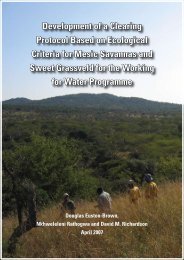Business Case forthe Pongola-Umzimkulu Catchment Management ...
Business Case forthe Pongola-Umzimkulu Catchment Management ...
Business Case forthe Pongola-Umzimkulu Catchment Management ...
You also want an ePaper? Increase the reach of your titles
YUMPU automatically turns print PDFs into web optimized ePapers that Google loves.
<strong>Business</strong> <strong>Case</strong> for the <strong>Pongola</strong>-<strong>Umzimkulu</strong> <strong>Catchment</strong> <strong>Management</strong> Agency<br />
(characteristically smaller users). The CMA will, in due course,collect these charges and be<br />
responsible for debt management. The efficiency of collection of charges currently by DWA<br />
has been a matter of concern in some parts of the country. Although it is difficult to obtain<br />
accurate figures from DWA, this efficiency seems to be in the order of 40% - 80%, with<br />
figures for Kwa-Zulu Natal indicating collection in the order of 75%. This then means that<br />
the WRM charges here represent a stable and significant source of income and cash-flow for<br />
the CMA. Since the CMA will be closer to water users and have a more direct relationship<br />
with them than DWA, and since it will be more directly dependent on revenue from water<br />
use charges than DWA, it is expected that the CMA will quickly improve upon these levels of<br />
collection.<br />
The CMA will require an establishment grant to cover all costs during the first 2 years,<br />
before responsibility for water use charge billing and collection is transferred from DWA to<br />
the CMA. This is basically unavoidable, because it will take at least 18 months after<br />
establishment for a CMA to be able to take over this function (linked to time required for<br />
setting up the systems and setting charges by the CMA the year before collection occurs).<br />
This is the de facto situation with the two existing CMAs. These funds should be transferred<br />
into the CMA account as a lump sum early in the establishment of the institution, to enable<br />
it to continue the establishment process without encountering cash-flow constraints.<br />
A 3 year budgetary cycle needs to be put in place for on-going operational support grants<br />
required by the CMA to make effective planning and execution possible. This can be<br />
transferred at the beginning of each financial year as a lump sum deposit, after the<br />
necessary adjustments for incorrect assumptions about key determinants of the budget e.g.<br />
inflation. A lump sum transfer is justified, as the funds are relatively small and interest<br />
accruing over the financial cycle will be limited. Significantly, lump-sum transfers will enable<br />
the CMA to conduct its operations and undertake its functions without encountering cashflow<br />
constraints.<br />
During the initial institutional establishment period capacity may well be stretched and the<br />
use of service providers will be required to assist with key operational matters. Payments<br />
from the <strong>Pongola</strong>-<strong>Umzimkulu</strong> CMA will be based on contracts between it and service<br />
providers.<br />
9.3 Financial systems arrangements<br />
Importantly, differing financial arrangements will exist during the evolution of the CMA,<br />
which have an important bearing on their financial responsibility and CMA viability. It is<br />
anticipated that the billing and collection of WRM charges for CMAs will initially be<br />
undertaken centrally, but that once a CMA has been established and is demonstrating sound<br />
governance and financial management, a process of decentralisation would begin (probably<br />
resulting in the development of a separate billing and financial management system by the<br />
CMA). This process is discussed here in more detail:<br />
• While DWA is still performing CMA functions that are not yet managed by the<br />
<strong>Pongola</strong>-<strong>Umzimkulu</strong> CMA, DWA will collect revenue and allocate funds within DWA<br />
and to the CMA (from the Trading Account).The existing system and business<br />
process for billing and collection of water use charges, with a consolidated invoice<br />
Department of Water Affairs 45
















